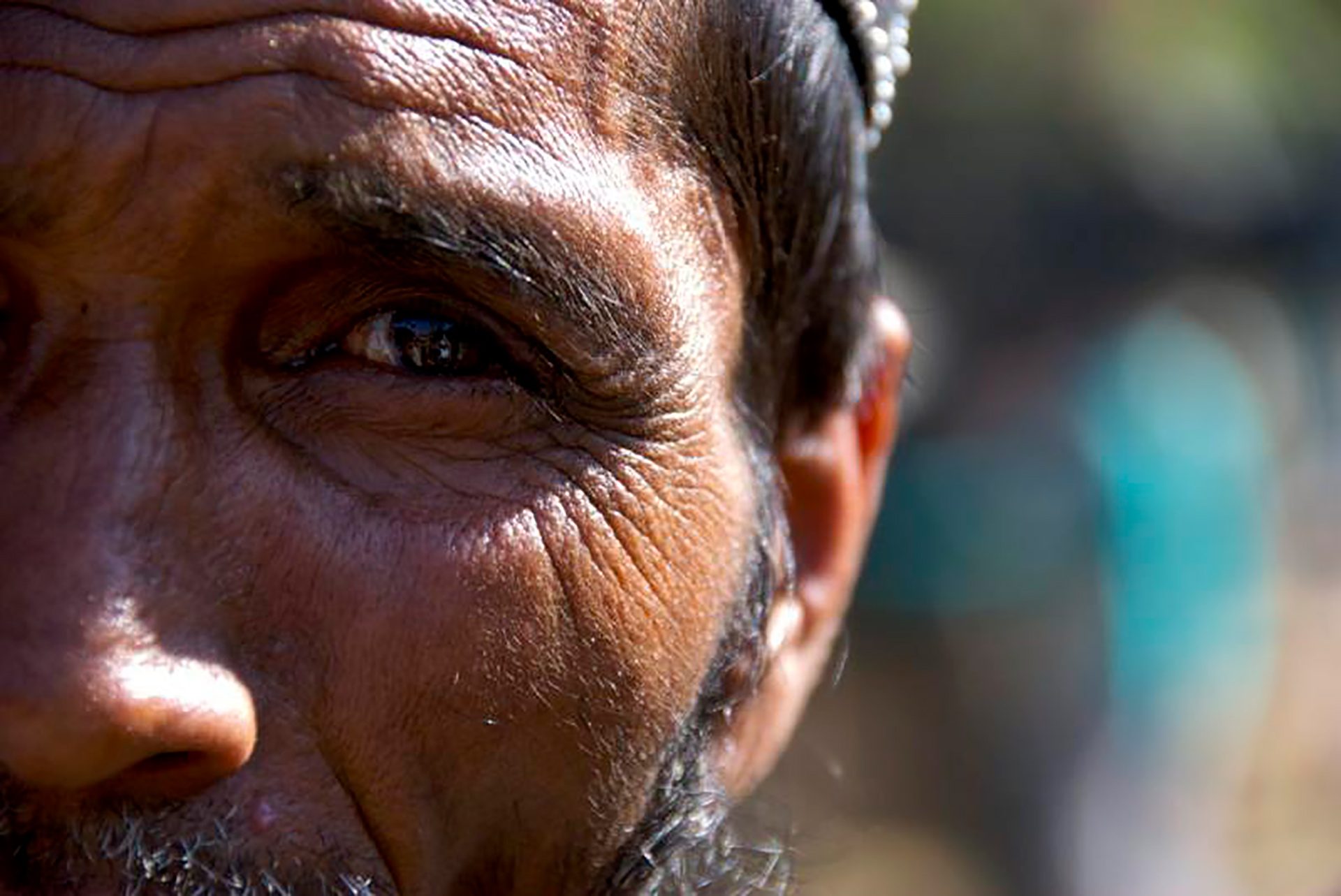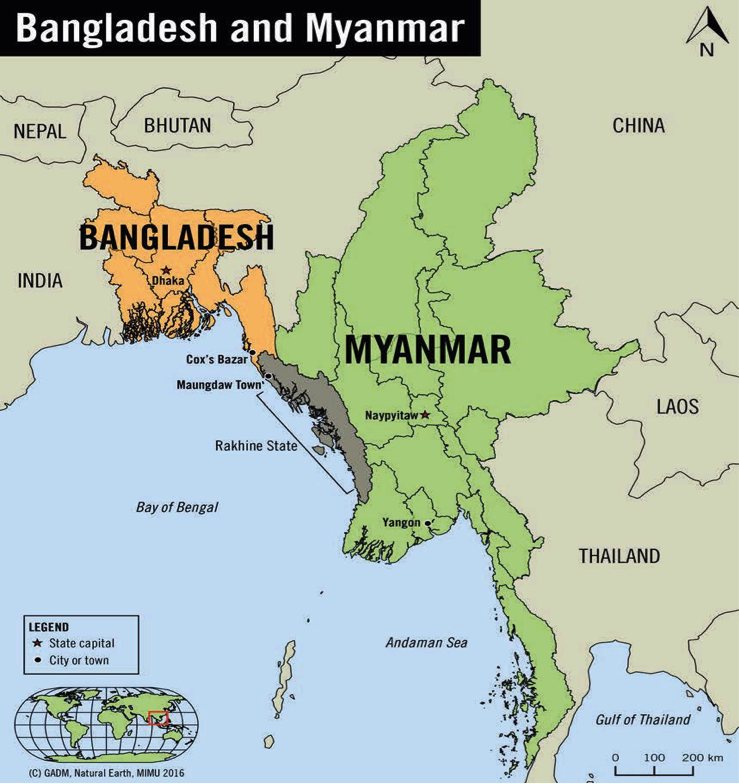
This post is the first in a four-part series about the current violent persecution and ethnic cleansing of the Rohingya in Myanmar. Each part of this series will examine a different aspect of the crisis. To begin, we provide a general background of the current violence against the Rohingya.
By Eleonora Costa
When trying to understand the Rohingya crisis, it is important to understand the historical and social underpinnings of the current violence; understanding the Rohingya population’s history, and the discriminatory ideas held about the Rohingya in Myanmar. In this short piece, I will try to shed some light on these basic aspects, essential to understanding the escalating violence in Myanmar.
Myanmar, also known as Burma, is a sovereign state in Southeast Asia, bordered by India and Bangladesh to its west, Thailand, Laos to its east and China to its north and northeast. The majority of the population practices Buddhism, but other major religions such as Christianity and Islam are also present in the country. The Muslim minority lives in the north-western state of Rakhine and it is commonly known as Rohingya. Rohingya have been named by reporters and institutions as the ‘most persecuted minority in the world’.
The Rakhine state, previously called Arakan, was in the past inhabited by two major groups: the Arakanese, ethnic Rakhine Buddhists, and Muslim traders that arrived in the independent Kingdom of Arakan in the 8th century. They were followed, in the 18th century, by tens of thousands of Bengali Muslims captured by the Arakanese. In the following centuries, Arakan was conquered first by the Burmese army and then by the British in 1825. Soon after, the freedom of movement across the region increased and a great number of Bengalis moved to Arakan to work. This worsened the relationship between Arakanese and the Muslim population (at this point composed by Bengalis and the Muslims that had been there since the 8th century), because of stereotypical perceptions linked to the job market. “This mass immigration boosted the colonial economy, but local Arakanese bitterly resented it. They had no control over it, believing that their jobs and land were being taken over by people whom they still call ‘illegal immigrants,’ or just (pejoratively) ‘Bengalis.”[1] In the aftermath of the Second World War, Arakan took the name of ‘Rakhine,’ which we currently use. Claims by the Rohingya were unheard both in the post-war period and in Myanmar’s post-independence governments. The Rohingya- who decry the notion that they are merely Bengali immigrants and emphasize their rich heritage in the old Arakan kingdom- call for citizenship as an indigenous ethnic group of Myanmar[2].

A law approved in 1982 ultimately denied the Rohingya the right to Myanmar citizenship and rendered the minority stateless. “Under the law, Rohingya were again not recognized as one of the country’s 135 ethnic groups. The law established three levels of citizenship. In order to obtain the most basic level (naturalized citizenship), there must be proof that the person’s family lived in Myanmar prior to 1948, as well as fluency in one of the national languages. Many Rohingya lack such paperwork because it was either unavailable or denied to them. As a result of the law, their rights to study, work, travel, marry, practice their religion and access health services have been and continue to be restricted. The Rohingya cannot vote and even if they jump through the citizenship test hoops, they have to identify as ‘naturalized’ as opposed to Rohingya, and limits are placed on them entering certain professions like medicine, law or running for office.”
Today, many people in Myanmar continue to believe that Rohingya are simply Bengali Muslim immigrants without any historical tie to Arakan and without rightful claim to citizenship. A noodle seller based in Yangon may well believe that “they [the Rohingya] are terrorists to the native population.”[4] Another Buddhist man, an inhabitant of the Rakhine State, went on record, explaining to CNN with palpable worry that he thinks that Rohingya “are expanding, they produce so many kids, so many children.”[5] The International Crisis Group has noted that these nationalist narratives are prevalent among the majority of the population, even if Buddhists comprise around 90% of the population and Muslims just 4% [6]. These shared, prejudicial beliefs are possible thanks to widespread disinformation. Most of the population indeed get informed through social media and, not always being able to be critical readers, they become bearers of stereotypes and fake news. “Social media messaging has driven much of the rage in Myanmar. Though widespread access to cell phones only started a few years ago, mobile penetration is now about 90 percent. For many people, Facebook is their only source of news, and they have little experience in sifting fake news from credible reporting.”[7]
611,000 new arrivals in Bangladesh are reported as of the 7th of November according to the International Organisation for Migration (IOM)[8]. These are the numbers of refugees since the 25th of August 2017, when Rohingya militants attacked police posts in the northern part of Rakhine, provoked hard retaliation on civilians and a consequent exodus of Rohingya towards Bangladesh. To give a realistic dimension to this number, we can make a comparison. The number of refugees and migrants that arrived in Europe between the 31st of August 2017 and the 7th of November 2017 is 21,328.[9] In the same period, Bangladesh has received 30 times more refugees than Europe. While this is, of course, a rough calculation and comparison-Bangladesh and Europe are different in many ways, starting from territorial size, economic resources and capacities- comparing the crises between two regions enables us to further contextualize the scale of this crisis in Myanmar/Bangladesh.
Rohingya are fleeing because they are targeted by the Burmese militaries and by angry Buddhist mobs. They are facing being burned alive, raped, tortured, and murdered. Their flight from Myanmar is also incredibly dangerous, mainly due to the risky ways of traveing[10] and the reported landmines at the border with Bangladesh[11]. For the Rohingya, however, like so many persecuted groups around the world, “the simple truth is that refugees would not risk their lives on a journey so dangerous if they could thrive where they are” (Melissa Fleming, UNHCR[12]).
*Views expressed in this story reflect those of the author and not an organizational stance by PCRC.*
References
Map: Source: Amnesty International Report “MYANMAR: ‘My world is finished’. Rohingya targeted in crimes against humanity in Myanmar” of 18/10/2017, accessed on the 20/11/2017 at https://www.amnesty.org/en/documents/asa16/7288/2017/en/
[1] The Economist, “The Rohingyas: the most persecuted people on Earth?” – published online on 13/06/2015. Accessed on 08/11/2017 at https://www.economist.com/news/asia/21654124-myanmars-muslim-minority-have-been-attacked-impunity-stripped-vote-and-driven
[2] Ibid.
[3] Al Jazeera, “Myanmar: Who are the Rohingya?” – published online on 28/09/17. Accessed on 08/11/2017 at http://www.aljazeera.com/indepth/features/2017/08/rohingya-muslims-170831065142812.html
[4] Katie Hunt, “How Myanmar’s Buddhists actually feel about the Rohingya”, published on CNN on 20/09/2017. Accessed online on 20/11/2017 at http://edition.cnn.com/2017/09/19/asia/myanmar-yangon-rohingya-buddhists/index.html
[5] Ibid.
[6]International Crisis Group, “Buddhism and State Power in Myanmar”- REPORT n. 290 of 5 September 2017. Accessed online on 20/11/2017 at https://www.crisisgroup.org/asia/south-east-asia/myanmar/290-buddhism-and-state-power-myanmar
[7] Hannah Beech for the New York Times, “Across Myanmar, Denial of Ethnic Cleansing and Loathing of Rohingya” – published online on 24/10/2017. Accessed on 08/11/2017 at https://www.nytimes.com/2017/10/24/world/asia/myanmar-rohingya-ethnic-cleansing.html
[8] Inter Sector Coordination Group (ISCG), “Situation Update: Rohingya Refugee Crisis” as of 7th of November 2017.
Accessed on 08/11/2017 at https://reliefweb.int/report/bangladesh/iscg-situation-update-rohingya-refugee-crisis-cox-s-bazar-7-november-2017
[9] 151,728 total arrivals in Europe in 2017 (updated at 08 Nov 2017) minus – 130,400 arrivals in Europe (as of 31 august 2017) = 21,328 arrivals in Europe between the 31st of August 2017 and the 08th of November 2017). Sources: http://data2.unhcr.org/en/situations/mediterranean#_ga=2.55086891.1469134512.1510148923-508200764.1508400095 and https://data2.unhcr.org/en/documents/download/59081 , accessed online on 08/11/2017.
[10] BBC, “Rohingya face dangerous sea journeys as they flee Myanmar”. Accessed online on 09/11/2017 at http://www.bbc.com/news/av/world-asia-41436984/rohingya-face-dangerous-sea-journeys-as-they-flee-myanmar
[11] Human Rights Watch, “Burma: Landmines Deadly for Fleeing Rohingya”. Accessed online on 09/11/2017 at https://www.hrw.org/news/2017/09/23/burma-landmines-deadly-fleeing-rohingya
[12] Accessed online on 08/11/2017 at http://www.unhcr.org/europe-emergency.html


